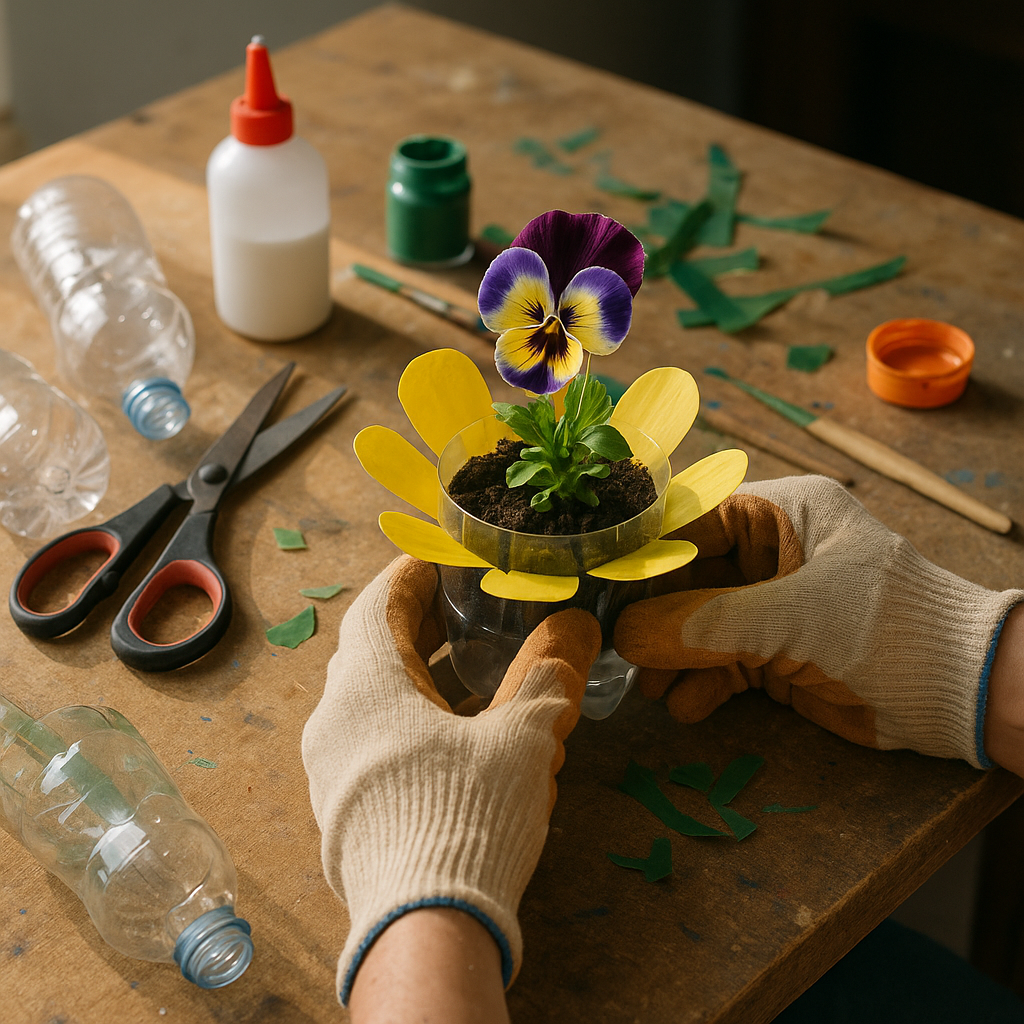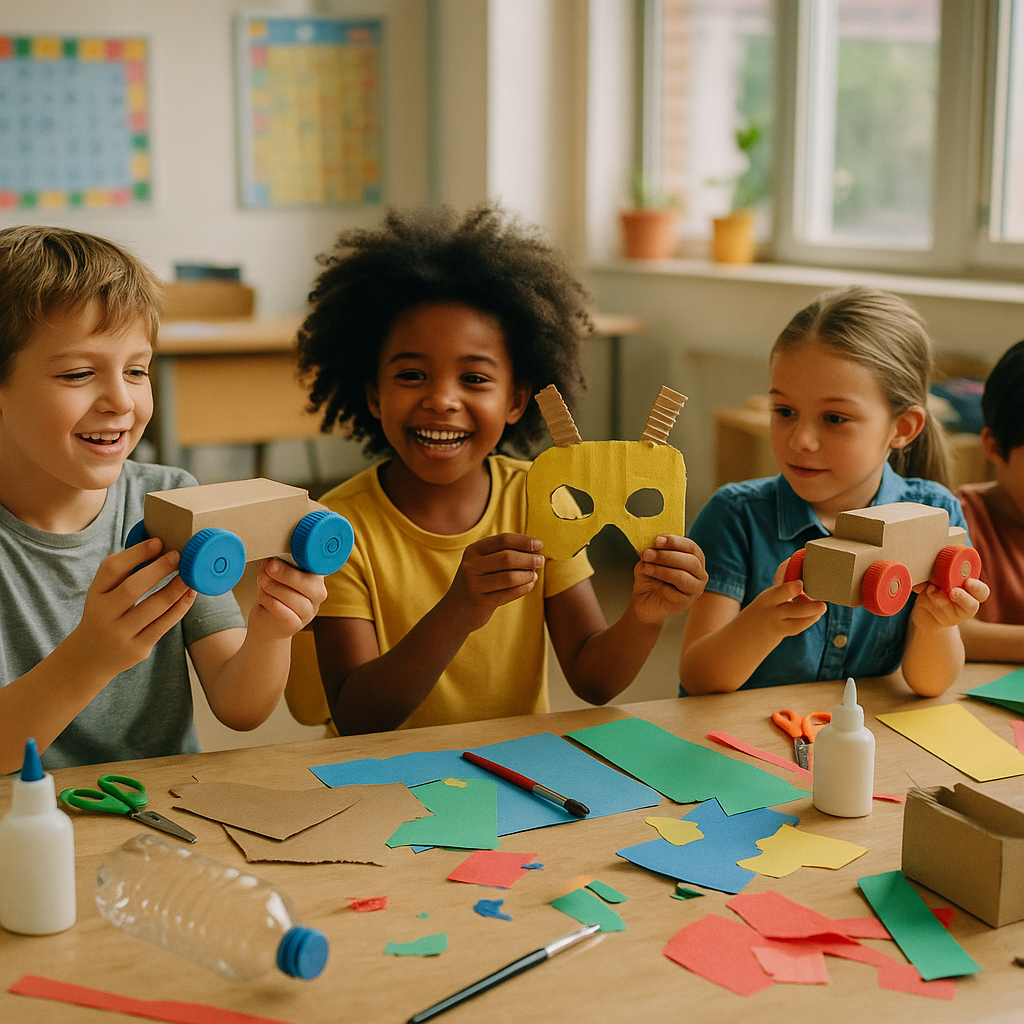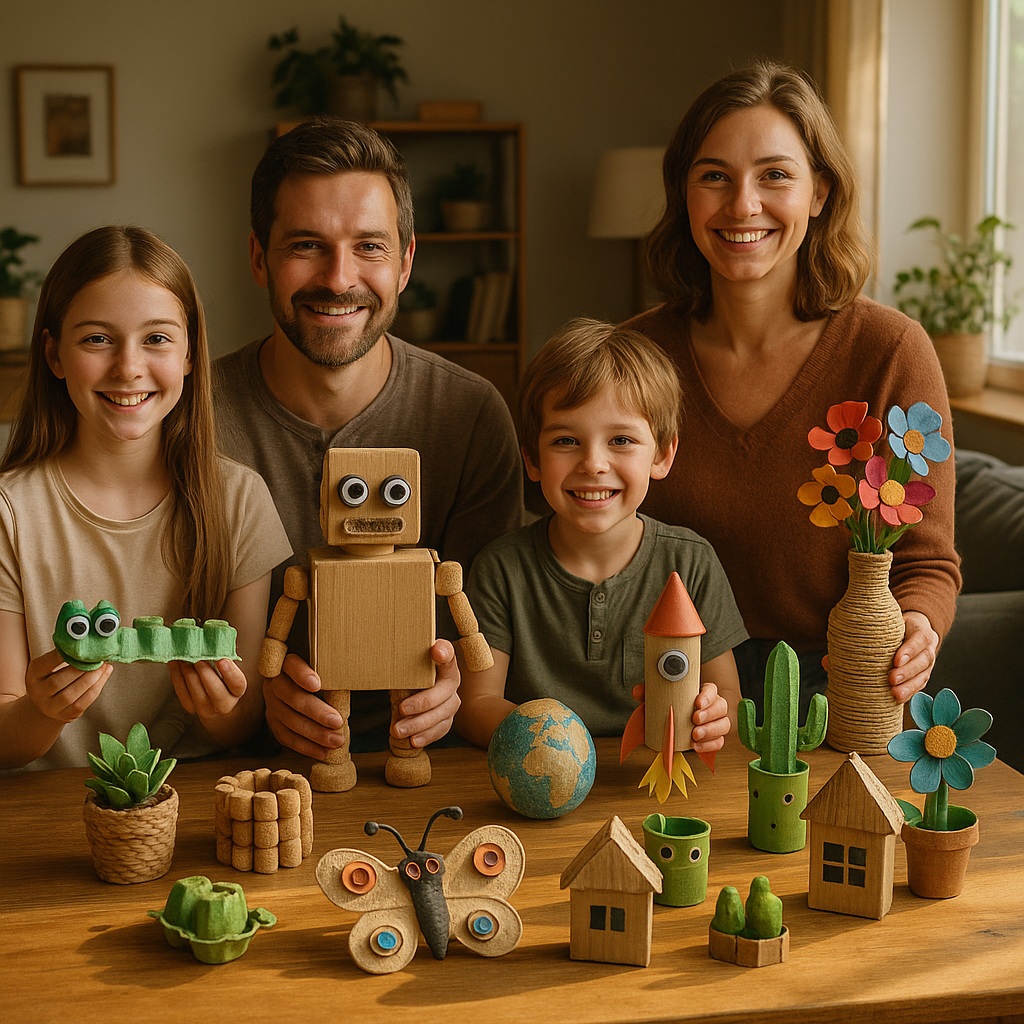5901 Botham Jean Blvd, Dallas, TX 75215
Creative Ways to Reuse Recycled Materials: DIY Crafts for Home, Kids, and Decor
August 28, 2025Transforming everyday waste into beautiful, functional items is both satisfying and environmentally responsible. Recycled materials offer a multitude of possibilities for creative expression while helping reduce landfill waste. The journey from trash to treasure often requires little more than imagination and basic supplies.
Glass jars become stylish lanterns with a coat of paint and a tea light. Plastic bottles transform into colorful planters, bird feeders, or decorative wind spinners. Old tin cans, once cleaned and decorated, make charming wind chimes that sing with every breeze. Cardboard tubes from paper towels or toilet paper rolls become building blocks for children’s toys, organizational solutions, or artistic masks.
Bottle caps, often overlooked in recycling efforts, can be collected and arranged into mosaic art, magnets, or jewelry. Fabric scraps find new purpose in patchwork projects, stuffed toys, or as wrapping for wire hangers. These simple transformations not only keep materials out of landfills but also allow for personal creative expression in ways that commercial products never could.
How Can You Turn Plastic Bottles into Useful Items?

Plastic bottles are a common household waste item, yet they offer remarkable potential for creative reuse. With minimal tools and effort, you can transform these everyday objects into functional items that serve practical purposes around your home and garden.
Upcycling plastic bottles not only reduces waste but also allows for custom solutions tailored to your needs. The durable nature of plastic makes these items surprisingly long-lasting, often serving their new purpose for years.
Create a Self-Watering Planter
One practical way to repurpose plastic bottles is by turning them into self-watering planters for herbs or small plants. This project requires just a bottle, scissors, and a few minutes of your time.
Start by thoroughly washing and drying a plastic bottle. Cut it horizontally about one-third from the bottom. Take the top section, remove the cap, and flip it upside down so it nests inside the bottom section, creating a reservoir and a planting area.
Fill the bottom section with water up to about an inch below where the inverted top will sit. Add soil to the top section, plant your seeds or seedlings, and place it into the water reservoir. The soil will draw water up through the bottle opening, keeping plants perfectly hydrated without overwatering.
These planters work well for herbs in kitchens or for starting seedlings before transplanting them to your garden. You can even paint the bottles or wrap them in decorative paper to match your decor.
Craft a Practical Bird Feeder
Another simple yet rewarding project is transforming a plastic bottle into a bird feeder, which attracts wildlife to your yard while providing a valuable food source for local birds.
For this project, you’ll need a clean plastic bottle, a pencil, scissors, and bird seed. Begin by making two small holes directly opposite each other about 2 inches from the bottom of the bottle. Push a wooden spoon, dowel, or pencil through these holes to create a perch for birds.
Above each perch, cut a 1-inch feeding hole. The hole should be large enough for birds to access the seed but small enough that the seed doesn’t pour out. Add more perch-and-hole combinations higher up on the bottle if desired.
Fill the bottle with bird seed, replace the cap, and hang the feeder from a tree branch using string or wire threaded through holes near the top. Position it where you can easily view visiting birds from your window.
This simple bird feeder attracts various species and provides hours of birdwatching enjoyment. It’s also easy to refill and clean—simply unscrew the cap to add more seed.
| Project | Materials Needed |
| Recycled Bird Feeder | Plastic bottle, string, scissors, pencil, bird seed |
| Pop Bottle Terrarium | Plastic bottle, soil, seeds/seedlings |
| Plastic Bottle Watering Can | Plastic bottle |
| Plastic Bottle Flower Vase | Plastic bottle, wool/paint/felt |
| Plastic Bottle Green Wall | Plastic bottles, sturdy beam or wall |
| Plastic Bottle Garden Hedgehog Feature | Plastic bottle |
| Plastic Bottle Boat | Plastic bottles |
The beauty of plastic bottle crafts lies in their simplicity and accessibility. Specialized tools or materials aren’t necessary—just imagination and a willingness to see waste as a resource. Whether crafting planters, bird feeders, or other functional items, you’re participating in meaningful recycling that keeps plastic out of landfills and oceans while creating something uniquely useful.
As you become more comfortable with basic bottle transformations, consider exploring more complex projects like garden scoops, pencil holders, or even decorative lights. Each plastic bottle you repurpose represents a small but significant step toward reducing waste and embracing creativity.
What Craft Projects Can Kids Make with Recycled Materials?

Recycled materials provide an exciting foundation for children’s creativity while teaching valuable lessons about sustainability. Common household items like egg cartons, toilet paper rolls, and bottle caps can transform into imaginative craft projects that are both fun and educational.
Egg Carton Creations
Egg cartons are versatile for countless kid-friendly projects. Children can make colorful flower bouquets by cutting individual cups, painting them, and attaching pipe cleaners as stems. This simple activity helps develop fine motor skills and color recognition.
Animal figures are another popular egg carton craft. Kids can turn the cups into turtles with painted shells, caterpillars with googly eyes, or birds with colorful feathers. These projects link well with lessons about wildlife and habitats, making them great for classroom science units.
For structured learning, egg carton sections can be sorting containers for counting exercises or math games. Children practice numerical skills while engaging with recycled materials, reinforcing the idea that learning tools don’t require new purchases.
Toilet Paper Roll Adventures
Empty toilet paper rolls serve as building blocks for imaginative play items. Children can decorate them to create telescopes or binoculars, perfect for backyard exploration or nature walks. Parents can enhance educational value by including a simple scavenger hunt list of items to spot.
These cardboard tubes can also become puppets when decorated with features and attached to craft sticks. Kids use these creations to act out stories, boosting language development and narrative skills. Teachers can incorporate these puppets into classroom storytelling sessions or dramatic play centers.
For STEM-focused activities, toilet paper rolls become the foundation for simple engineering projects. Children can connect multiple tubes to create marble runs, teaching basic physics concepts through hands-on exploration of gravity and motion.
Bottle Cap Possibilities
Plastic and metal bottle caps offer unique opportunities for creative reuse. Children can arrange them into colorful mosaics or patterns, developing spatial awareness and design skills. These activities work well in group settings where kids can collaborate on larger murals or displays.
Game pieces are another practical use for bottle caps. Kids can create custom board games using bottle caps as markers or playing pieces. This project combines art with strategic thinking as children design game boards and establish rules.
Bottle caps also suit sorting and matching activities. Young children can practice color recognition by grouping similar caps, while older kids might use them for pattern sequencing or math exercises. The tactile nature of these materials makes learning more engaging than traditional methods.
Integrating Recycled Crafts into Education
Parents and teachers can maximize the educational impact of these projects by connecting them to broader learning objectives. Recycled crafts naturally complement environmental education, helping children understand concepts like waste reduction and resource conservation through hands-on experience.
These activities also support various developmental domains. Fine motor skills improve as children cut, paint, and assemble. Cognitive skills develop through problem-solving and creative thinking. Social skills strengthen when projects are collaborative experiences.
Recycled crafts fit perfectly into project-based learning approaches for classroom use. Teachers can design units where students collect materials, research creative reuse ideas, and develop their eco-friendly projects. This process builds research skills alongside environmental awareness.
How Can Recycled Materials Be Used for Home Decor?
Transforming everyday waste items into beautiful home decor is not only environmentally responsible—it opens the door to creating unique pieces that reflect your personal style. The increasing interest in upcycled home decor is driven by both environmental consciousness and the desire for distinctive, conversation-starting items that won’t strain the budget.
Explore some of the most adaptable recycled materials and how they can bring new life to your living spaces with minimal investment and maximum creativity.
Kitchen Containers as Decorative Storage
Those tin cans from your pantry deserve a second look before hitting the recycling bin. With a coat of spray paint and some creative embellishments, they become stylish organizational tools. By using the same color palette across multiple cans, you can create coordinated sets.
For a vintage look, attach printed botanical images or old recipes to the outside using decoupage medium. After drying, sand the edges lightly for an authentically distressed appearance. These containers work beautifully for holding kitchen utensils, craft supplies, or as desktop organizers.
Glass Jars as Versatile Decor Elements
Mason jars and other glass containers are incredibly versatile for home decor projects. Turn them into rustic lanterns by adding wire handles and inserting LED lights or candles. For a more sophisticated appearance, dip jars in colored wax or apply metallic paint for an upscale finish.
Creating jar lanterns is surprisingly simple. Clean the jars thoroughly, decorate the exteriors with paint or decoupage, and add wire wrapped around the mouth of the jar to form a handle. These make perfect additions to patios, dining tables, or as bathroom accents.
Wooden Pallets for Functional Furniture
Wooden pallets are among the most versatile recycled materials for larger home decor projects. With basic tools and some sanding, these industrial castoffs can become standout furniture pieces. Pallet coffee tables offer rustic charm and practical functionality with minimal construction skills required.
For a simpler project, wall-mounted pallet shelves require just cleaning, sanding, and secure mounting. They create ideal display spaces for books, plants, or decorative items. The natural variations in the wood add character that mass-produced furniture simply can’t match.
Fabric Scraps for Textile Accents
Don’t discard old clothing, curtains, or linens. Fabric scraps can be repurposed into stunning textile home accents. Create patchwork pillowcases, table runners, or decorative wall hangings using complementary fabric pieces sewn together.
For those less inclined to sew, simple no-sew projects like fabric-wrapped canvas art or rag garlands bring color and texture to spaces. Even small scraps can become fabric flowers for decorative bowls or wreaths, adding soft elements to counterbalance harder surfaces in your decor scheme.
Paper Products for Wall Art
Magazines, newspapers, and old books offer materials for sophisticated wall art. Create mosaic designs by cutting colorful magazine pages into shapes and arranging them on canvas. Old book pages can be crafted into paper flowers or decoupaged onto furniture for literary charm.
For a striking wall piece, arrange magazine cutouts into color gradients or thematic collections. The juxtaposition of different paper textures and colors creates visual interest that draws the eye and sparks conversation about sustainability.
Plastic Bottles for Creative Planters
Plastic bottles represent one of our most challenging waste streams, but they can become charming planters with minimal effort. Cut bottles horizontally to create hanging planters, or vertically for wall-mounted herb gardens.
For more refined looks, wrap bottles in twine, burlap, or decorative paper before adding soil and plants. These lightweight containers work especially well for succulents and small houseplants, bringing greenery to unexpected spaces in your home.
Adding Personality Through Recycled Decor
The beauty of recycled home decor lies in its uniqueness. No two pieces will ever be identical, creating truly one-of-a-kind elements for your home. These projects also invite personalization—incorporate family photos, meaningful text, or color schemes that reflect your personality.
Start small with simpler projects before advancing to more complex furniture pieces. The satisfaction of creating something beautiful from materials that would otherwise be discarded brings joy beyond the aesthetic value of the finished items.
Finding Inspiration for Your Projects
Local thrift stores, garage sales, and even neighborhood recycling bins can yield unexpected treasures for your next project. Keep an open mind about materials—sometimes the most unlikely items create the most stunning results.
Before discarding anything, consider its potential for transformation. That chipped teapot might become a charming succulent planter. Wine corks could form a bulletin board. Even old keys can become artistic wall hangings when grouped together.
With creativity and basic tools, ordinary household waste transforms into extraordinary decor that adds character and sustainability to any home. The environmental impact reduction is just a bonus to the unique aesthetic these projects bring to your living spaces.
| Material | Reuse Projects | Benefits |
|---|---|---|
| Glass Jars | Lanterns, Vases, Storage Containers | Versatile and decorative, recyclable |
| Plastic Bottles | Planters, Bird Feeders, Wind Spinners | Lightweight, durable, reduces waste |
| Tin Cans | Wind Chimes, Storage Containers | Readily available, easy to paint and decorate |
| Cardboard Tubes | Building Blocks, Organizers, Crafts | Biodegradable, easy to cut and assemble |
| Bottle Caps | Mosaic Art, Magnets, Jewelry | Compact, colorful, suitable for small projects |
| Fabric Scraps | Patchwork, Stuffed Toys, Wrapping | Low-cost, customizable, diverse textures |
Conclusion: Embracing Creativity and Sustainability Through Recycled Crafts

Creating items from recycled materials is not just a fun hobby but a meaningful step toward reducing waste and promoting sustainability. By transforming plastic bottles into planters, turning cardboard tubes into animal figurines, or making collages from old magazines, we actively contribute to reducing waste. These creative efforts help keep materials out of landfills, giving them new purpose and beauty.
The appeal of sustainable crafting lies in its accessibility. Anyone can get involved regardless of age, skill level, or budget. With just a few basic supplies and items from your recycling bin, you can embark on a creative journey that benefits both your well-being and the planet. Each project becomes a small but meaningful contribution to environmental conservation.
Ready to begin your own recycled crafting adventure? Contact Okon Recycling at 214-717-4083 for your recycling needs and take the first step toward turning waste into wonderful creations.
